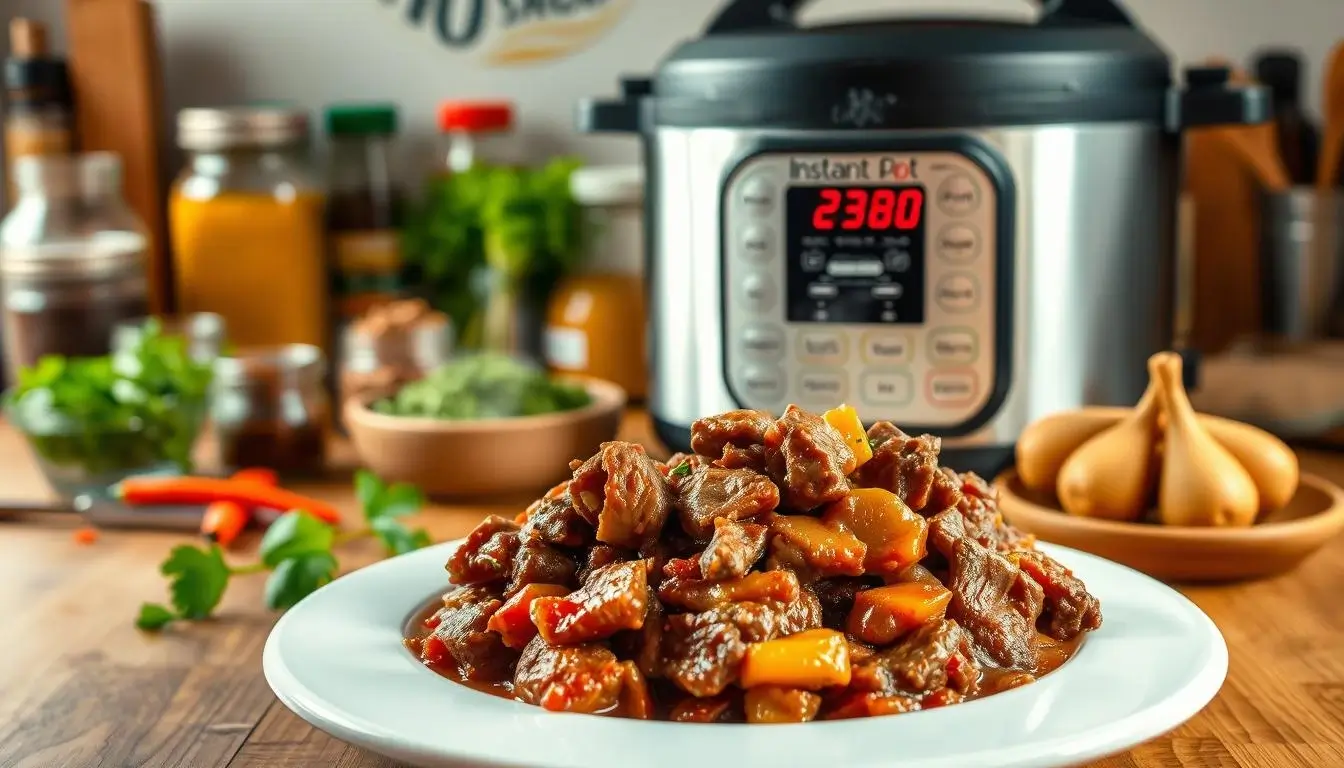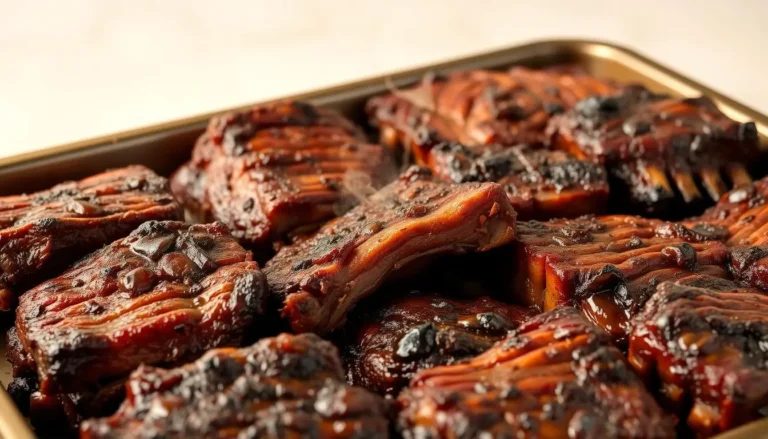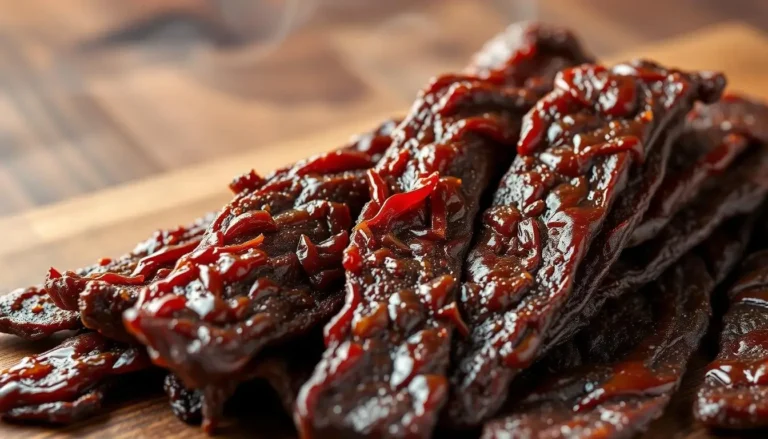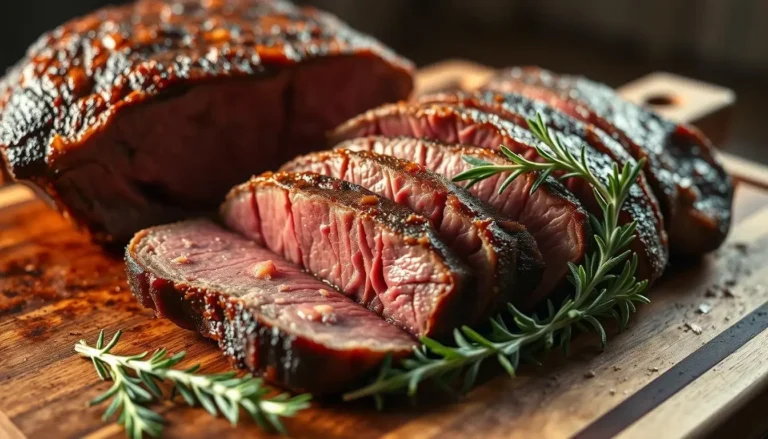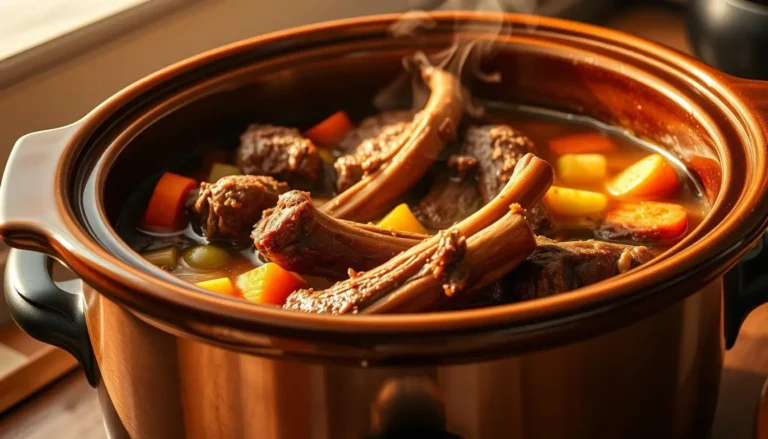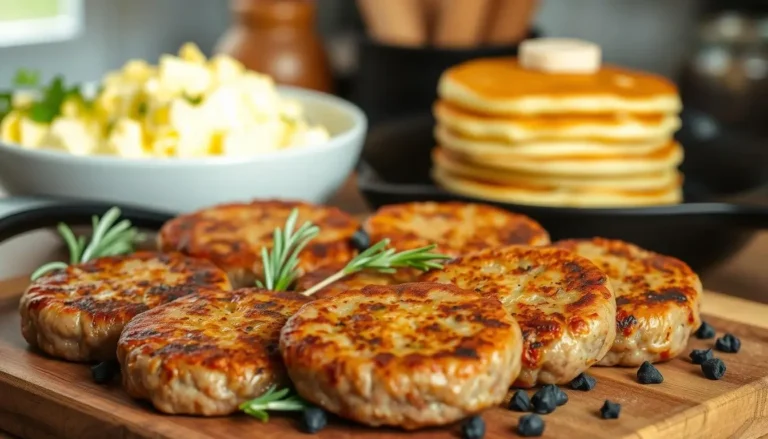How to Make Instant Pot Recipes with Ground Beef: Easy and Quick Meals
Table of Contents
Instant pot recipes ground beef
What if you could turn simple ingredients into a weeknight meal that’s both fast and full of flavor? For busy home cooks, the challenge often lies in balancing time, cost, and taste. That’s where your pressure cooker becomes a game-changer.
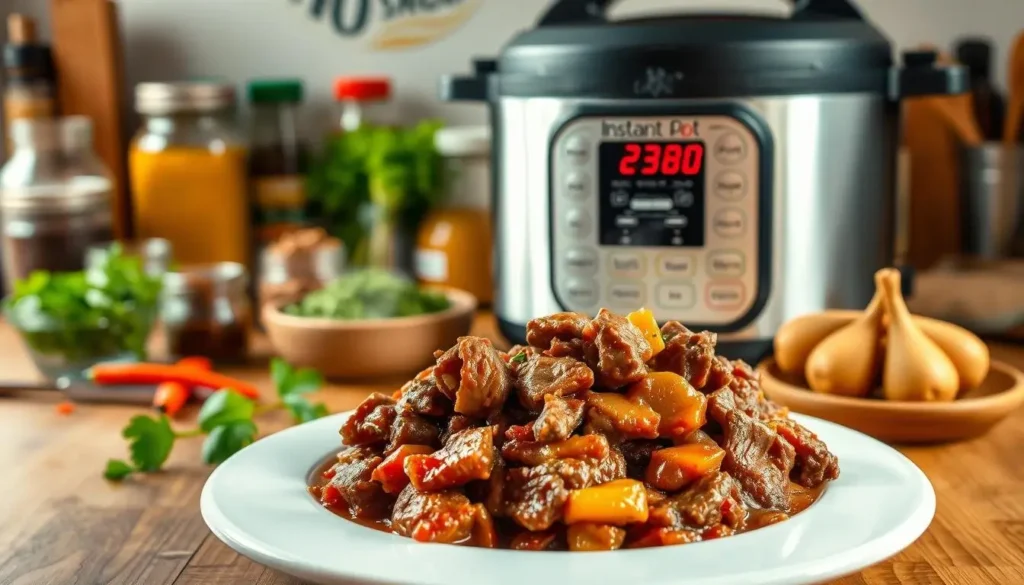
Modern kitchen tools like the multi-functional cooker simplify everything from browning meat to layering flavors. Its sauté function lets you sear ingredients directly in the pot, while pressure cooking locks in moisture and reduces cooking time by up to 70%. No more juggling pans or waiting hours for dinner.
Affordable, versatile proteins like lean meat are perfect for this approach. They absorb spices beautifully and pair well with veggies, grains, or pasta. Whether you’re craving chili, tacos, or casseroles, this ingredient adapts effortlessly to your cravings.
Key Takeaways
- Master efficient techniques to brown meat and build flavor in one pot.
- Use the sauté and pressure cook functions to cut prep and cleanup time.
- Explore budget-friendly meal ideas that suit picky eaters or last-minute plans.
- Learn how to layer spices and ingredients for maximum taste in minimal steps.
- Discover solutions for turning simple staples into satisfying family dinners.
Introduction to Instant Pot Ground Beef Cooking
Ever wondered how a single kitchen gadget can revolutionize your cooking routine? This versatile appliance turns ordinary ingredients into restaurant-worthy meals with minimal effort. By combining browning and pressure cooking in one device, you lock in rich flavors while cutting active prep time.
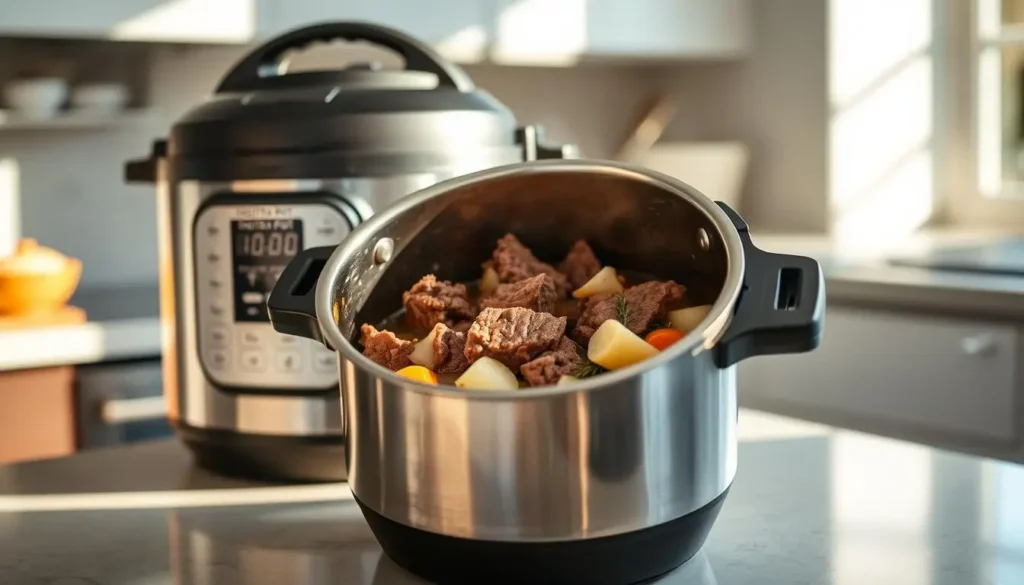
Start by using the sauté function to caramelize your protein. This step builds a flavor foundation through Maillard reaction – the chemical process that creates depth in dishes. Once browned, switch to pressure mode. The sealed environment infuses spices evenly while tenderizing tougher cuts in minutes.
Mastering these techniques opens doors to countless meal options. Think smoky chili with beans, creamy stroganoff over egg noodles, or zesty taco fillings. Each dish benefits from the cooker’s ability to meld ingredients without constant stirring.
Why does this method work so well? High-pressure steam forces liquids into food fibers, resulting in juicier textures compared to stovetop methods. You’ll also use fewer dishes since everything cooks sequentially in the same insert pot.
Benefits of Using an Instant Pot for Ground Beef Meals
Imagine trimming your kitchen routine while amplifying taste. Pressure cookers achieve both by transforming basic ingredients into hearty dishes faster than conventional methods. Culinary experts note these devices cut active cooking time by 40-60%, letting you focus on family instead of stove-watching.
Why does this method excel? The sealed environment forces steam into meat fibers, creating unmatched tenderness without drying. Unlike stovetop simmering, which can toughen proteins, pressurized heat breaks down connective tissues evenly. Home cooks report richer flavors in chili and pasta sauces compared to traditional boiling.
Cleanup becomes effortless since everything cooks in one pot. No more scrubbing multiple pans or dealing with grease splatters. Batch cooking also shines here—prepare large quantities of taco fillings or meat sauces, then freeze portions for later.
| Method | Cook Time | Flavor Depth | Cleanup Effort |
|---|---|---|---|
| Stovetop | 45-60 mins | Moderate | High |
| Pressure Cooker | 15-20 mins | Intense | Low |
Busy parents love the multitasking potential. Start sautéing aromatics, then add other ingredients without switching appliances. Reviews highlight how weekday dinners feel less rushed when meals come together in half the usual time.
Essential Ingredients and Tools for Quick Instant Pot Recipes
Getting dinner on the table quickly starts with the right foundation. Your ingredient choices and equipment directly impact cooking efficiency and flavor. Let’s break down what you need to succeed.
Choosing the Right Protein Blend
Fat content matters when selecting meat. An 80% lean blend releases more grease, requiring extra draining steps. Leaner options like 90% or 93% reduce excess oil, keeping your dish lighter without sacrificing moisture.
Always pat the meat dry before cooking. This simple step improves browning and prevents steaming. For rice-based dishes or casseroles, leaner blends help maintain ideal texture in shorter cooking times.
Must-Have Kitchen Tools
Your appliance’s stainless steel insert ensures even heat distribution. Pair it with a silicone sealing ring that locks in steam for consistent results. A sturdy slotted spoon helps stir ingredients without clumping.
| Tool | Purpose | Impact |
|---|---|---|
| Stainless Insert | Even Heating | Prevents Burning |
| Sealing Ring | Pressure Maintenance | Faster Cook Times |
| Slotted Spoon | Gentle Mixing | Avoids Overhandling |
| Trivet | Elevates Food | Prevents Sogginess |
Precision timers are non-negotiable. Set alerts for each cooking phase—overcooking by mere minutes can turn tender meat into rubber. Tested tools eliminate guesswork, letting you focus on layering flavors instead of fixing mistakes.
Mastering the Sauté Function for Perfectly Browning Beef
Perfectly browned meat isn’t just luck—it’s science you can control. The sauté setting transforms your appliance into a high-heat skillet, creating caramelized edges that elevate every bite. Let’s break down how to harness this feature like a pro.
Step-by-Step Browning Techniques
- Prep your meat: Pat it dry with paper towels. Moisture steams instead of searing.
- Preheat the insert: Use the sauté mode on “normal” for 2 minutes until hot.
- Cook in batches: Spread meat in a single layer. Overcrowding causes uneven cooking.
- Stir strategically: Let it sit untouched for 90 seconds to form a crust before breaking apart.
- Drain excess fat: Tilt the pot and use a spoon to remove grease halfway through.
Tips to Minimize Grease and Enhance Flavor
Choose leaner blends (90% or higher) to reduce oil pooling. After browning, deglaze the pot with broth or wine. This lifts flavorful bits stuck to the bottom while adding complexity.
| Grease Management | Flavor Boosters | Common Mistakes |
|---|---|---|
| Use slotted spoon | Add smoked paprika | Stirring too often |
| Blot with bread | Mix Worcestershire sauce | High moisture content |
| Chill & skim | Toast spices first | Insufficient preheating |
Season in layers: salt during cooking, herbs after pressure release. This prevents bitterness from overcooked spices. For balanced meals, pair with acidic ingredients like tomatoes or vinegar to cut richness.
instant pot recipes ground beef
Weeknights demand creativity without complexity—discover how versatile proteins shine in your pressure cooker. From classic comfort foods to globally inspired dishes, this appliance turns humble ingredients into memorable meals. Let’s explore ideas that balance simplicity with bold flavors.
Craving Italian? Try a deconstructed lasagna with ricotta swirls and no-boil noodles. Layer meat sauce directly in the pot, then top with cheese before pressure cooking. For Hungarian flair, goulash gains depth when paprika and caraway seeds simmer under high steam. Both dishes cook in under 25 minutes.
Transform traditional beef stroganoff by swapping sour cream for Greek yogurt. The tangy twist adds protein while maintaining creaminess. Serve over zucchini noodles or cauliflower rice for a low-carb option. Food bloggers praise this method for retaining the dish’s richness without heaviness.
- Tex-Mex stuffed peppers: Mix cooked grains with spiced meat, stuff into bell peppers, and pressure-steam until tender.
- Korean-inspired bowls: Toss browned protein with gochujang sauce, then pair with quick-pickled veggies.
- Moroccan meatballs: Simmer in tomato broth with cinnamon and raisins for sweet-savory balance.
Don’t shy away from fusion experiments. Blend teriyaki glaze into meatloaf mixtures or add curry powder to shepherd’s pie fillings. These tweaks keep family meals exciting while using pantry staples. Remember: your cooker’s steam environment intensifies spices, so start with less and adjust after cooking.
Quick and Delicious Instant Pot Beef Dinners for Families
Need dinner solutions that satisfy everyone without the hassle? Trusted food bloggers and home cooks have perfected meals that turn chaotic evenings into stress-free family time. These crowd-pleasers balance nutrition, flavor, and simplicity—often requiring just 5-10 minutes of prep.
Top Recipe Picks from Trusted Sources
Allrecipes’ 5-star Cheesy Pasta Bake combines tender noodles with marinara and melted mozzarella in 22 minutes. Testers love how the cooker prevents overcooked pasta while infusing rich tomato flavor. For lighter options, Pinch of Yum’s “30-Minute Taco Soup” layers smoky spices with black beans and corn—ideal for freezing leftovers.
| Recipe | Main Ingredients | Cook Time | Source |
|---|---|---|---|
| Weeknight Lasagna | Ground turkey, no-boil noodles | 18 mins | Food Network |
| Korean Beef Bowl | Thinly sliced steak, gochujang | 15 mins | Damn Delicious |
| Creamy Chicken Alfredo | Chicken breasts, fettuccine | 20 mins | Budget Bytes |
Swapping proteins keeps meals fresh. Try shredded chicken in place of beef for chili or stir-fries. TheKitchn recommends using thighs instead of breasts for juicier results in curries. Most dishes come together faster than preheating your oven!
Busy parents praise these one-pot wonders for minimizing cleanup. As blogger Cookie + Kate notes: “My kids devour the cheesy shells, and I love having only one dish to wash.” With smart ingredient choices and your cooker’s versatility, wholesome dinners become effortless.
Diverse Flavor Profiles: From Chili to Stroganoff
Your cooker unlocks a world of flavors by letting you pivot between global cuisines with spice swaps. Whether you crave heat, umami richness, or velvety textures, smart ingredient choices transform basic dishes into memorable meals.
Exploring Spicy, Savory, and Creamy Variations
For fiery meals, amp up taco fillings with chipotle powder and fire-roasted tomatoes. Food & Wine suggests balancing heat with lime crema—mix sour cream, zest, and cilantro. Want extra indulgence? Fold shredded pepper jack into the meat before serving.
Cream-based dishes like stroganoff thrive with tangy contrasts. Substitute heavy cream with Greek yogurt during pressure release. Add a dash of hot sauce to cut through richness. This tweak adds brightness without overpowering earthy mushrooms.
| Dish | Key Spices | Flavor Twist | Cook Time |
|---|---|---|---|
| Smoky Chili | Cumin, smoked paprika | Dark chocolate shavings | 25 mins |
| Cheesy Tacos | Ancho chili, oregano | Queso fresco topping | 18 mins |
| Creamy Stroganoff | Dill, mustard powder | White wine deglaze | 22 mins |
Experiment with textures too. Crispy tortilla strips add crunch to saucy enchiladas. For meatballs, blend breadcrumbs with grated Parmesan to lock in moisture. The Kitchn recommends toasting spices first to intensify their aroma.
Don’t shy away from fusion ideas. Try adding garam masala to sloppy joes or miso paste to meat sauces. Your family’s preferences guide the journey—start with small spice adjustments and taste as you go.
Cooking Techniques: Pressure Release and Managing Liquid
Mastering your appliance’s pressure settings transforms good meals into great ones. Two release methods—quick and natural—determine texture and flavor retention. Natural release (letting pressure drop on its own) works best for tender meats or broths. Quick release (manually venting steam) suits delicate ingredients like veggies or pasta to prevent mushiness.
After sautéing, always deglaze the pan with broth, wine, or water. Scrape those flavorful browned bits using a wooden spoon—they’re packed with savory depth. Add minced garlic here to infuse aromatic richness into sauces or stews. This step also prevents burn warnings by loosening stuck-on food.
Liquid ratios matter. Most dishes need at least 1 cup of broth or water to build steam. Too little? Your cooker won’t pressurize. Too much? Flavors dilute. If sauces seem thin after cooking, thicken them with a cornstarch slurry (1 tbsp starch + 2 tbsp water). Stir it in during the sauté phase for glossy results.
Troubleshooting tips:
- If liquid evaporates too fast, check the sealing ring for cracks
- For overly thick sauces, add a splash of broth and simmer uncovered
- Layer ingredients properly—starchy items like rice go on top to avoid scorching
Balancing moisture and heat ensures consistent results. Start with tested ratios, then adjust based on your protein and veggie mix. Remember: proper technique turns simple ingredients into restaurant-quality dishes without the guesswork.
Recipe Variations: Taco Meat, Meatloaf, and More
Reinventing family favorites starts with smart tweaks to classic formulas. Your pressure cooker breathes new life into traditional dishes like meatloaf and tacos while keeping weeknight meals exciting. Let’s explore how small adjustments create big flavor shifts.
Classic Recipes vs. Modern Twists
Traditional meatloaf relies on breadcrumbs and ketchup glaze. Modern versions might use oats or almond flour for texture. Adding ½ cup beef broth keeps it moist under pressure. For tacos, swap store-bought seasoning packets with smoked paprika and lime zest.
| Dish | Classic Version | Modern Twist | Liquid Adjustment | Cook Time |
|---|---|---|---|---|
| Meatloaf | Breadcrumbs, egg | Quinoa, sun-dried tomatoes | +¼ cup broth | 25 mins |
| Taco Filling | Chili powder | Chipotle + cocoa powder | -2 tbsp water | 12 mins |
Broth does double duty—it enhances savoriness while preventing dryness. Use 1 cup for meatloaf mixtures or ¾ cup for saucy taco bases. Too little liquid? Your dish might scorch. Too much? Flavors become diluted.
Seasoning swaps for diverse tastes:
- Italian: Basil + fennel seeds in meatloaf
- Tex-Mex: Cumin + coriander in taco meat
- Asian-inspired: Ginger + soy sauce blends
Balance liquids precisely. For pasta dishes, reduce broth by ⅓ cup if using jarred sauce. Always deglaze the pot after sautéing to capture every bit of flavor. These tweaks turn routine recipes into weeknight wonders.
Troubleshooting Common Instant Pot Ground Beef Issues
Even seasoned cooks face challenges when perfecting pressure-cooked dishes. Understanding how to adjust techniques ensures your meals stay juicy and flavorful every time. Let’s tackle common pitfalls and their fixes.
Solving Texture and Grease Challenges
Rubbery meat often stems from overcooking. Reduce cook time by 2-3 minutes if using lean blends. For fatty mixes, drain grease halfway through sautéing. Blotting with a paper towel before cooking also minimizes excess oil.
Maintaining consistent high pressure prevents uneven results. Check the sealing ring for cracks and ensure the valve isn’t blocked. If steam escapes during cooking, reset the lid and restart the cycle.
| Issue | Cause | Solution |
|---|---|---|
| Dry Texture | Overcooking | Cut time by 15% |
| Greasy Sauce | High fat content | Chill & skim |
| Burnt Bottom | Insufficient liquid | Add ½ cup broth |
Many easy instant recipes suggest shorter times, but altitude affects pressure. Increase liquid by ¼ cup if you’re above 3,000 feet. For stews, layer ingredients—place veggies on top to avoid mushiness.
Struggling with flavor balance? Deglaze the pot thoroughly after browning. Add acidic components like tomatoes early to tenderize meat. Adjust spices after cooking since high pressure intensifies seasonings.
Meal Prep and Batch Cooking Tips for Busy Weeknights
What if your freezer held the secret to stress-free evenings? Strategic batch cooking lets you build a rotating menu of ready-to-heat meals. Start by choosing dishes that freeze well—think chili, pasta sauces, or seasoned protein blends.
Strategies for Freezer-Friendly Dishes
Portion control matters. Divide large batches into single servings or family-sized containers. Use silicone muffin tins for individual portions of broth-based soups. Label everything with dates to track freshness.
- Double recipes when making stews or casseroles—freeze half for later
- Cool dishes completely before sealing to prevent ice crystals
- Vacuum-seal marinaded meat for flavor-packed future meals
Homemade broth boosts taste without additives. Simmer vegetable scraps with herbs, then freeze in ice cube trays. Drop these flavor bombs into reheated dishes for a restaurant-quality finish.
| Dish Type | Broth Usage | Freezer Time | Servings per Container |
|---|---|---|---|
| Soups | 2 cups | 3 months | 4 |
| Casseroles | ½ cup | 2 months | 6 |
| Meat Sauces | ¼ cup | 4 months | 8 |
Experienced home cooks recommend planning two prep days monthly. Cook one base ingredient (like seasoned meat) and three complete meals. This balances variety with efficiency—you’ll always have options without repetition.
Conclusion
Transforming everyday meals into culinary delights doesn’t require hours in the kitchen. By mastering efficient techniques like sautéing and pressure cooking, you unlock rich flavors while minimizing excess fat. The right tools and lean protein blends let you create tender, juicy dishes without greasy messes.
From smoky chili packed with tomatoes to creamy stroganoff lightened with yogurt, these methods prove speed and taste coexist. Testimonials from busy cooks highlight how layering spices and using broth-based sauces elevates simplicity. A dollop of cream or sprinkle of fresh herbs adds restaurant-quality flair in minutes.
Don’t hesitate to experiment. Swap ingredients like diced tomatoes for roasted red peppers or try low-fat cheese in casseroles. Each adjustment personalizes meals while keeping prep under 30 minutes. As one food blogger notes: “The best dishes often come from playful tweaks to trusted basics.”
Remember: great cooking thrives on simplicity. With staples like canned tomatoes, broth, and a dash of cream, you’re equipped to craft satisfying dinners that feel indulgent yet balanced. Now it’s your turn—grab that cooker and let flavor lead the way.
FAQ
How does using a pressure cooker save time compared to stovetop for ground beef dishes?
Pressure cookers drastically cut cooking time by trapping steam, which speeds up the process. Dishes like chili or pasta bakes that take hours on the stove can be ready in under an hour, with minimal hands-on effort.
What’s the best way to brown meat using the sauté function without excess grease?
Pat the beef dry before cooking and use a medium heat setting. Drain excess fat after browning, or opt for leaner meat (90/10) to reduce grease while keeping the dish flavorful.
Can you prepare dishes like chili or stroganoff in one pot without pre-cooking ingredients?
Yes! The sauté function lets you brown meat, cook aromatics, and simmer sauces all in one pot. Just layer ingredients properly and adjust cooking times based on recipe guidelines.
How do you adjust liquid levels to prevent dishes from being too watery?
Use broth or tomatoes sparingly, as the cooker retains moisture. Start with 1 cup of liquid for most recipes, and thicken sauces afterward using cornstarch or a quick simmer.
What are some family-friendly meals that can be made quickly?
Try taco bowls, cheesy pasta bakes, or sloppy joes. These dishes take 20-30 minutes and can be customized with veggies or mild spices for picky eaters.
How do you store and reheat leftovers without losing flavor?
Cool leftovers completely before sealing them in airtight containers. Reheat on the stove with a splash of broth or in the microwave, covered, to retain moisture.
What kitchen tools are essential for efficient cooking?
A sturdy silicone spatula, trivet, and fat separator streamline the process. Measuring cups and a quality knife set also help prep ingredients faster.
How can you adapt classic recipes for dietary restrictions like gluten-free or low-fat?
Swap regular pasta for chickpea or rice noodles, and use Greek yogurt instead of sour cream. For lower fat, choose lean meat and skip added oils during sautéing.
What are common mistakes when using the pressure release function?
Releasing pressure too quickly can cause splattering. For natural release, wait 10-15 minutes before turning the valve. For quick release, use a towel to shield your hand.
Any tips for freezing meals without texture issues?
Avoid freezing dairy-heavy dishes. Portion meals into freezer bags, press out air, and label with dates. Thaw overnight in the fridge before reheating gently.

